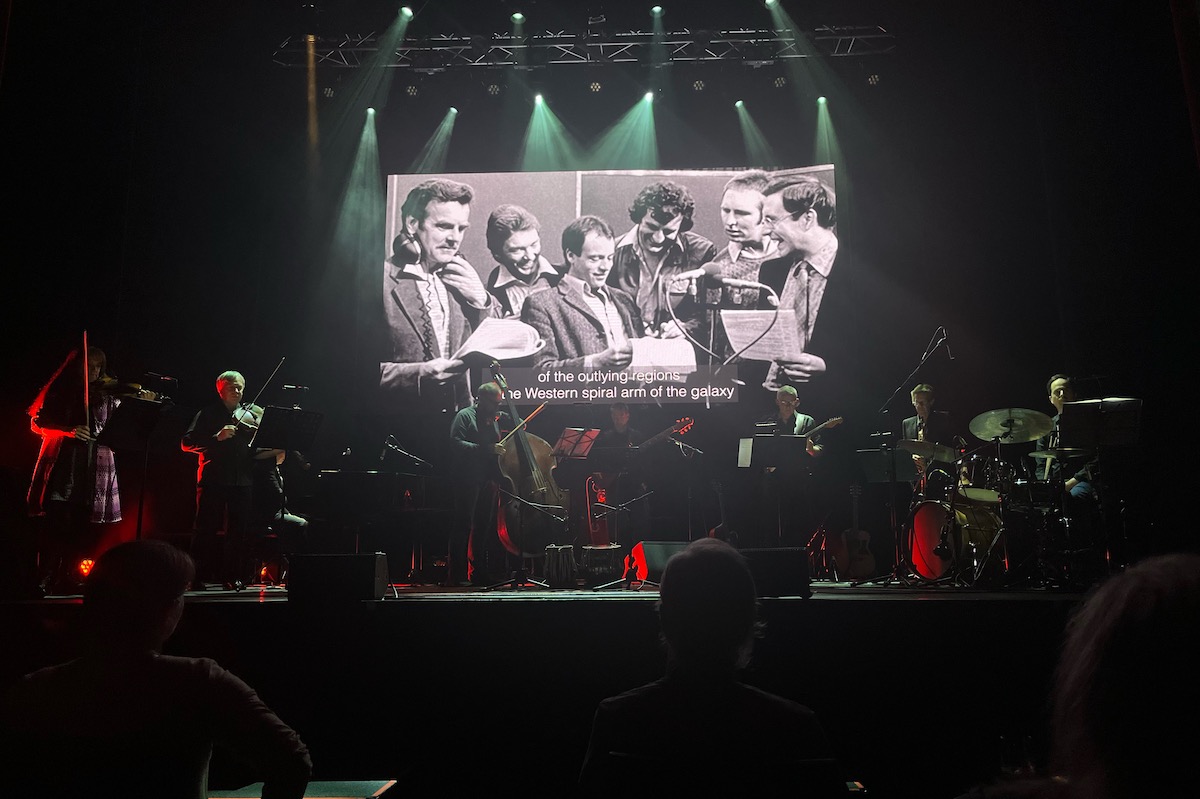A lot has changed in the world since the invention of wireless communication in 1901, when Guglielmo Marconi received the first transatlantic wireless signal and ushered in the age of radio.
This collaboration between the internationally renowned quintet Topology and the talented local trio Loops sends us hurtling backwards from 2001 to 1901 in a musical celebration of a century of radio. Originally commissioned for the Queensland Biennial Festival of Music in 2001, this 75-minute work takes the form of 99 brief tracks of radio clips accompanied by a unique musical score, projected images and film footage. This encore presentation was timed to celebrate the centenary of regular radio broadcast in Australia, which began in 1924.

Airwaves – 100 Years of Radio. Photo © Gemma Regan
The evening began with DJ JD (Loops’ Jonathan Dimond) tapping a warning in Morse code to turn off our phones (the large screen behind the eight musicians deciphering the code for all to oblige). Instantly, we were whirled back through time in a musical Tardis to experience the jubilations, achievements and horrors of the 20th Century.
Tuning In featured reports on the euthanasia of an 86-year-old Dutchman tired of living, spy planes from China and the upgrade of Laing Park stadium in Australia. The sax of Topology’s John Babbage and Dimond’s funky bass guitar were prominent in a continuous flow of events, with names, dates and news projected on screen.
Dimond, guitarist Jamie Clark and double bass player Robert Davidson, founder and director of Topology, each contributed to the compositions. Elsewhere, some tracks were unaccompanied, leaving us to absorb the original, sometimes poignant and occasionally disturbing transmissions.
Davidson also edited the video and audio, a monstrous task. Choosing the momentous events of a century inevitably gives a biased and subjective view and can skew historical truths. Fortunately, his was a less pessimistic reflection of humanity, with some light-hearted comedy from the Goons. At one point, the band joined in with the BBC Radiophonic Workshop, creating slips and whoops on the instruments and comical ditties on the violin.
Quartet for the End of Empire took the form of an announcement by the young Princess Elizabeth with sister Margaret (from a 1940 broadcast, Children’s Hour) in which the future Queen urges the children of today to make the future a happier place. The mournful violin of Christa Powell and Therese Milanovic’s sombre piano accompanied Babbage’s spoken sax intonation as a polistylism – where each syllable is a single note, mimicking the speech patterns.
This storytelling method was effective throughout the performance. Hitler was chillingly parroted on the guitar in Germany Is Awake (from 1933) with a pulsing ominous bass and discordant piano as the phrase is repeated, faster and faster.
Many excerpts were juxtaposed to illustrate the absurdity of humanity. A cleverly composed series of clips in Edward VIII Abdicates, accompanied by sarcastic mournful strings, has Edward saying “You know the reasons” before photographs of him visiting his good mate Adolf. That Woman: Bill Clinton has blends the President’s famous denial of Lewinsky with playing his sax; Babbage plays along with him.
Some of the frontiers of the 20th century are prominent, with a large aviation section featuring aviators Jean Batton, Emilia Earhardt and Charles Kingsford Smith. The Moon Landing: Neil Armstrong is sandwiched between Timothy Leary’s famous Turn On, Tune In, Drop Out and Malcolm X: Whites Can Help Us But They Can’t Join Us. Einstein gets several excerpts with Einstein On Pacifism and Einstein E=mc2.
A personal thrill was watching the recording of the iconic Sci-Fi radio show of the century in Hitchhikers Guide to the Galaxy, with a repetitive complaint from Marvin, the paranoid android.
There was a lot of guff from our Australian politicians and several local disasters, including the Brisbane Floods, Cyclone Tracy and Darwin Bombed. ABC: 1932 The Melbourne Cup was also interesting, where the musicians rhythmically galloped along with the horses.
The composition ended with as it had begun, Ouroboros style, with the letter ‘S’ in Morse Code (dit dit dit), transmitted in 1901 from Poldhu in Cornwall to Signal Hill in St Johns, Newfoundland.
Airwaves: 100 Years of Radio was a unique and overwhelming presentation which should be compulsory for all, given the benefits of hindsight in viewing a retrograde history. The cleverly sculpted musical accompaniment was delivered with skill and imagination, fulfilling Topology’s mission to unleash creativity.
This fascinating and chilling retrospective tone poem of the 20th century should serve as a warning to us for the 21st.











Comments
Log in to join the conversation.